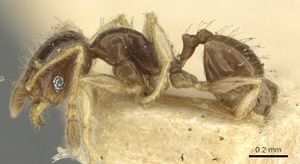Pheidole orbica
| Pheidole orbica | |
|---|---|

| |
| Scientific classification | |
| Kingdom: | Animalia |
| Phylum: | Arthropoda |
| Class: | Insecta |
| Order: | Hymenoptera |
| Family: | Formicidae |
| Subfamily: | Myrmicinae |
| Tribe: | Attini |
| Genus: | Pheidole |
| Species: | P. orbica |
| Binomial name | |
| Pheidole orbica Forel, 1893 | |
| Synonyms | |
| |
P. orbica may be a native species on St. Vincent and is likely local in distribution; Stefan Cover and I did not encounter it during a week’s collecting on the neighboring island of Grenada. H. H. Smith (in Forel 1893j) found it rare on St. Vincent, in well-developed forest, nesting in pieces of rotting wood on the ground, under stones in the soil, or, in one case, beneath sod on a stone. Each colony contained several hundred individuals. (Wilson 2003)
Identification
See the description in the nomenclature section.
Keys including this Species
Distribution
From Wilson (2003): Known from St. Vincent, West Indies, and from Arroyo, Puerto Rico, col. J. A. Torres.
Latitudinal Distribution Pattern
Latitudinal Range: 18.002° to 18.002°.
| North Temperate |
North Subtropical |
Tropical | South Subtropical |
South Temperate |
- Source: AntMaps
Distribution based on Regional Taxon Lists
Neotropical Region: Guadeloupe, Puerto Rico, St. Vincent.
Distribution based on AntMaps
Distribution based on AntWeb specimens
Check data from AntWeb
Countries Occupied
| Number of countries occupied by this species based on AntWiki Regional Taxon Lists. In general, fewer countries occupied indicates a narrower range, while more countries indicates a more widespread species. |

|
Estimated Abundance
| Relative abundance based on number of AntMaps records per species (this species within the purple bar). Fewer records (to the left) indicates a less abundant/encountered species while more records (to the right) indicates more abundant/encountered species. |

|
Biology
Castes
Worker
Minor
Images from AntWeb
   
| |
| Syntype of Pheidole orbica. Worker. Specimen code casent0901599. Photographer Ryan Perry, uploaded by California Academy of Sciences. | Owned by NHMUK, London, UK. |
   
| |
| Paralectotype of Pheidole orbica. Worker. Specimen code casent0908295. Photographer Will Ericson, uploaded by California Academy of Sciences. | Owned by MHNG, Geneva, Switzerland. |
Queen
Images from AntWeb
   
| |
| Syntype of Pheidole orbica. Queen (alate/dealate). Specimen code casent0901600. Photographer Ryan Perry, uploaded by California Academy of Sciences. | Owned by NHMUK, London, UK. |
Nomenclature
The following information is derived from Barry Bolton's Online Catalogue of the Ants of the World.
- orbica. Pheidole orbica Forel, 1893g: 415 (s.w.q.m.) ANTILLES. See also: Wilson, 2003: 480.
Unless otherwise noted the text for the remainder of this section is reported from the publication that includes the original description.
Description
DIAGNOSIS A member of the “flavens complex” within the larger flavens group, consisting of Pheidole asperithorax, Pheidole breviscapa (=Pheidole perpusilla), Pheidole exigua, Pheidole flavens, Pheidole nuculiceps, Pheidole orbica and Pheidole sculptior, as well as the less similar Pheidole nitidicollis and species placed close to it (see under nitidicollis), differing by the following combination of traits.
Major: occiput and entire body behind the head smooth and shiny; shallow antennal scrobes present, their surfaces partly carinulate and foveate and subopaque; a small patch of rugoreticulum present just laterad to the circular carinulae of the antennal fossae; longitudinal carinulae originating on the frontal lobes reach almost to the occiput, and those just mesad to the eye reach to halfway between the eye and occipital corner; promesonotum in side view forms a near-perfect semicircle; apex of petiolar node in side view acute.
Minor: except for sparse circular carinulae around the antennal fossae, head and body entirely smooth and shiny.
MEASUREMENTS (mm) Lectotype major: HW 0.82, HL 0.88, SL 0.42, EL 0.10, PW 0.38. Paralectotype minor: HW 0.40, HL 0.40, SL 0.36, EL 0.06, PW 0.24.
COLOR Major: body variably brownish yellow to light reddish brown.
Minor: body yellowish brown, appendages clear yellow.
Figure. Upper: lectotype, major. Lower: paralectotype, minor. Scale bars = 1 mm.
Type Material
ST. VINCENT, WEST INDIES, col. H. H. Smith. Musee d'Histoire Naturelle Genève - as reported in Wilson (2003)
Etymology
L orbica, circular, possibly referring to the semicircular profile of the promesonotum. (Wilson 2003)
References
- Wilson, E. O. 2003. Pheidole in the New World: A dominant, hyperdiverse ant genus. Harvard University Press, Cambridge, MA. (page 480, fig. major, minor described)
- Forel, A. 1893j. Formicides de l'Antille St. Vincent, récoltées par Mons. H. H. Smith. Trans. Entomol. Soc. Lond. 1893: 333-418 (page 415, soldier, worker, queen, male described)
- Meurgey, F. 2020. Challenging the Wallacean shortfall: A total assessment of insect diversity on Guadeloupe (French West Indies), a checklist and bibliography. Insecta Mundi 786: 1–183.
- Wetterer, J.K. 2021. Ants (Hymenoptera, Formicidae) of St. Vincent, West Indies. Sociobiology 68, e6725 (doi:10.13102/sociobiology.v68i2.6725).
References based on Global Ant Biodiversity Informatics
- Galkowski C. 2016. New data on the ants from the Guadeloupe (Hymenoptera, Formicidae). Bull. Soc. Linn. Bordeaux 151, 44(1): 25-36.
- Kempf, W.W. 1972. Catalago abreviado das formigas da regiao Neotropical (Hym. Formicidae) Studia Entomologica 15(1-4).
- Wheeler W. M. 1905. The ants of the Bahamas, with a list of the known West Indian species. Bulletin of the American Museum of Natural History 21: 79-135.
- Wilson, E.O. 2003. Pheidole in the New World: A Dominant, Hyperdiverse Genus. Harvard University Press


